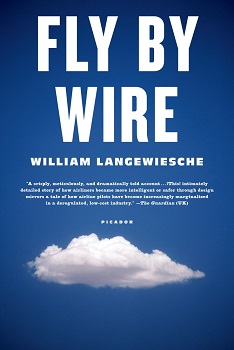
Fly by Wire
William Langewiesche
193 pages
published in 2009
I bought Fly by Wire because Alex raved about it a while back. It's subtitle, "The Geese, The Glide, The ‘Miracle’ on the Hudson" might clue you in that it's about that US Airways flight that had to crashland in the Hudson back in 2009, after having been hit by geese. Langewiesche is a reporter who has written several books about aviation and here he explains not just what happened that day, but also what made it possible for the pilot, Captain Sullenberger, to land it the way he did and how this fits in with a more general philosophical debate on airplane controls.
An interesting subject, but to be honest I was a bit disappointed with the book as I was expecting something more in-depth after Alex's review. What it instead reminded me off was one of those interminable New Yorker articles which take a single incident to illuminate a larger social trend. Langewiesche tracks the accident as it evolves, then cuts away to explain one aspect, goes back to the accident, cuts away, ultimately ending when Sullenberger has set down the plane and the rescue boats have brought everybody to the shore. On the whole it was decently done and not nearly as annoying to read than if it had been spread out over ten pages in an online article, but it could've done with a bit more depth. Also footnotes.
The main point Fly by Wire attempts to make is that the heroics of captain Sullenberger were only possible because of the airplane he was flying, the Airbus A320. This was the first commercial airliner to introduce fly by wire controls, complete with automatic flight envelope protection. This meant that it was no longer possible for pilots to overrule the flight computers, but that in dangerous situations these would automatically prevent against e.g. stalling the airplane. Pilots of course have always resisted this development, arguing that in certain circumstances these sort of automatic checks could lead to the loss of an aircraft. However, as Langewiesche reports, Airbus counters this by noting that of all accidents with their planes using fly by wire, none have been caused by these controls or the automatic protections.
In fact, Fly by Wire tries to show that it actually was the automatic safeguards that enabled captain Sullenberger to fly on the edge of the aircraft's flight envelope, making possible the long glide that ended in the Hudson. Because the pilot could put his plane right on the edge and trust the computer to keep it there and not cross it into the danger zone and he had the experience with the type of plane to know this, he didn't need to waste time and effort trying to find this edge.
That's something that a lot of pilots had and have problems accepting, and that other large civil airplane manufacturer, Boeing, always refused to accept this. In their planes fly by wire auto protection protocols can always be overridden by the pilot. Which, as Langewiesche shows, has contributed to several accidents as pilots tried to do in Boeings what the computer could've done more easily and quicker in an Airbus.
For pilots of course those sort of protections are just another way in which their authority and prestige are lessened, in the wake of the deregulation of the American airline industry. Being a pilot is not longer glamorous nor especially well paid, while work pressure has increased immensely yet they have increasingly less flying to do in the cockpit. It's no wonder that there was so much resistance from American pilots specifically against fly by wire controls. Langewiesche manages to explain this tension without denigrating the pilots for this resistance.
The conlusion Langewiesche comes to is perhaps inevitable that both pilot and plane were needed for that miraculous landing in the Hudson and that both could take the credit for it. As he also shows in the first chapter, dealing with the inquest to the accident, it was the pilot however who was best in grasping this opportunity, parlaying a temporary fame into financial stability for himself and his family. Which is perhaps not noble, but is sensible.
Webpage created 06-05-2014, last updated 14-05-2014.